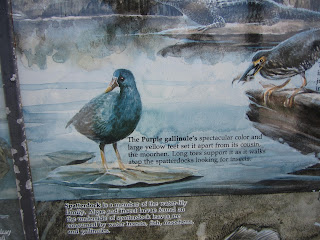On Wednesday, February 14, we entered Everglades National
Park where the entrance is near Homestead, FL.
The distance from the park entrance to Flamingo, FL is ~40 miles. We stopped at Long Pine Key Campground where
the road and the campsites were level and paved. The campsites did not have
water or electric, but it did have very clean bath houses.
February 15-21
The next morning, we continued on down to Flamingo stopping
at the Royal Palms area to walk around the Anhinga Trail and the Gumbo Limbo
Trail. In the event you are not familiar
with the Anhinga, it is a unique water bird that dives then can swim with just
its head out of the water. Then, it
dries its feathers by perching in a tree and spreading its wings for the sun to
dry it. Unlike other birds, it does not
have natural oil in its feathers. I did
not get a picture of it because it was too far away. But, I did get a reasonably close picture of
the Cormorant, pictured below, another water bird that also dives and can stay under water for
a lengthy time.
Another interesting bird on this trail was the Purple Gallinule. It walks on top of the lily pad type of water plant searching for food, but he is very quick so I did not get a picture of him, so I took a picture of the posted placard.
As we continued walking, we came upon a few alligators that
are always fun to see.
After we finished the Anhinga Trail, we walked the Gumbo
Limbo Trail. The Gumbo Limbo is a tree
native to this area whose bark can be bright red. The Gumbo Limbo tree (pictured below) was used
for carving carousel horses and the bark was brewed for the flavoring of gumbo
soup/stew.
There were hundreds of these Anoles and they didn’t seem to
mind how close we got to them.
Something I find fascinating is the Strangler Fig. This vine wraps itself around other trees,
sends its roots to the ground and heads for the sky, killing the tree it
wrapped around.
We continued on down to the Flamingo Visitor’s Center right
on the Florida Bay. The condition of
this place is pretty bad due to hurricanes in the past, and most recently
Irma. There were a lot of things broken
or destroyed and they have not yet recovered.
In the picture below, we are standing on the breaker wall looking out
over the Florida Bay.
The wildlife is just now starting to recover and we saw
several of the Red Shouldered Hawks pictured below.
On the breaker wall there was a fresh water drain where the
gentle Manatee came up and kept his mouth pressed against for the water.
The Flamingo, FL area is an interesting place. According to the rangers here, this is the
only place in the world that is inhabited with both alligators and crocodiles.
We saw this crocodile on the boat launch ramp.
Notice how much lighter in color the crocodile is compared to the
alligator above and how much narrower his snout is than the alligator snout.
We participated in a ranger lead activity on Saturday, February
17. This free activity was taking a
canoe trail through the mangrove trees.
Notice how clear the water is.
Again, the clear water.
I have to admit, the Everglades is nothing like what I
expected. I expected nothing but swamp
and lots of insects, but I was totally wrong.
The Everglades is mostly prairie grass that filters an eight mile wide
fresh water river, and its tributaries.
Due to all the grass filtering this slow moving river, the water is
unbelievably clear. There are plenty of
insects, but during our visit, the mosquitoes were a non-issue. Here is a picture of the prairie grass and if
you look closely, you can see the water.
We are leaving the southern tip of Everglades National Park on February 21st.
On the breaker wall there was a fresh water drain where the
gentle Manatee came up and kept his mouth pressed against for the water.
The Flamingo, FL area is an interesting place. According to the rangers here, this is the
only place in the world that is inhabited with both alligators and crocodiles.
We saw this crocodile on the boat launch ramp.
Notice how much lighter in color the crocodile is compared to the
alligator above and how much narrower his snout is than the alligator snout.
We participated in a ranger lead activity on Saturday, February
17. This free activity was taking a
canoe trail through the mangrove trees.
Notice how clear the water is.
Again, the clear water.
I have to admit, the Everglades is nothing like what I
expected. I expected nothing but swamp
and lots of insects, but I was totally wrong.
The Everglades is mostly prairie grass that filters an eight mile wide
fresh water river, and its tributaries.
Due to all the grass filtering this slow moving river, the water is
unbelievably clear. There are plenty of
insects, but during our visit, the mosquitoes were a non-issue. Here is a picture of the prairie grass and if
you look closely, you can see the water.
We are leaving the southern tip of Everglades National Park on February 21st.






















No comments:
Post a Comment